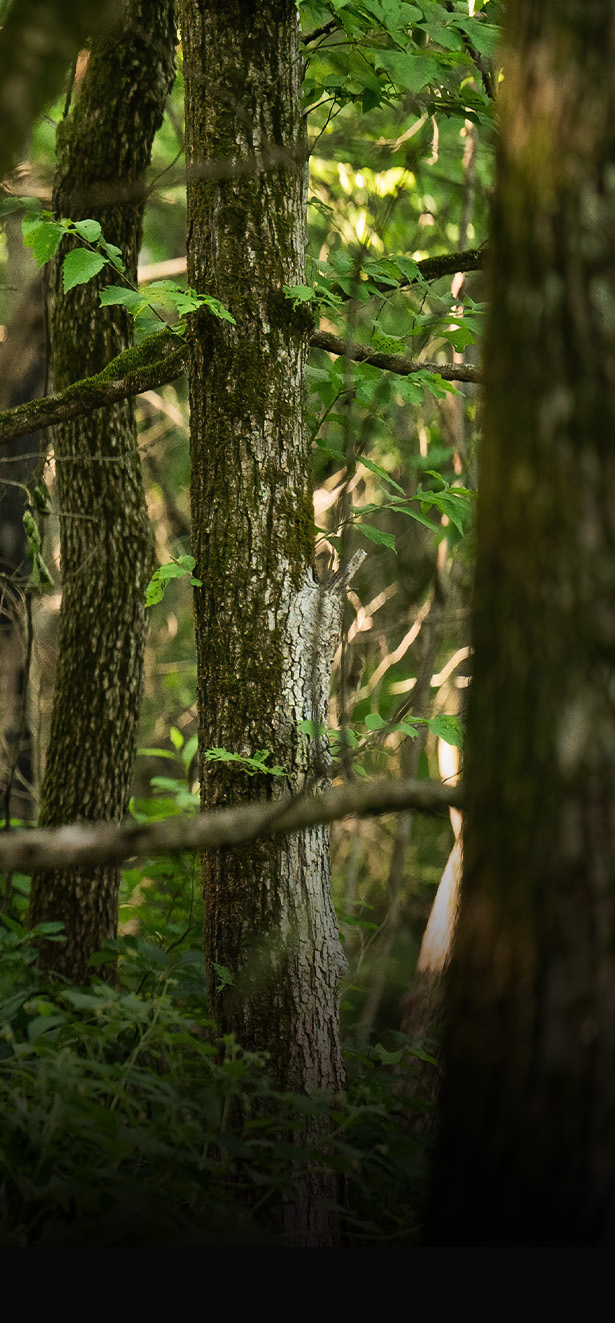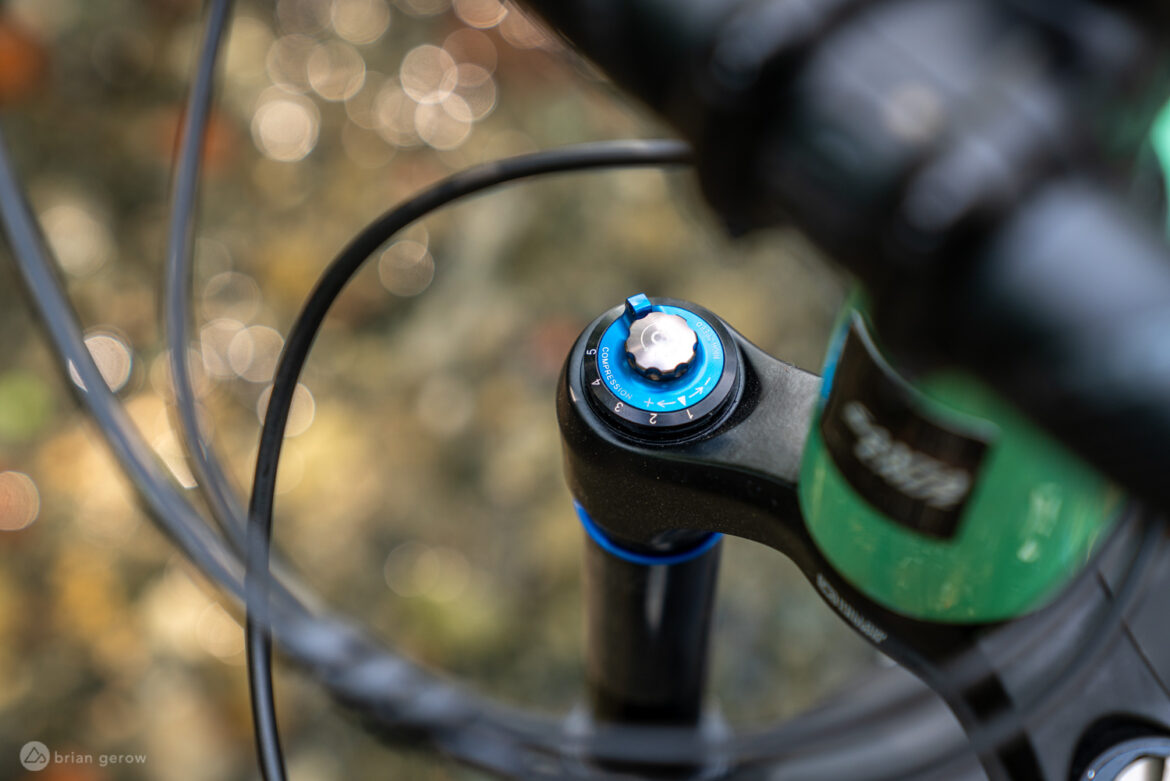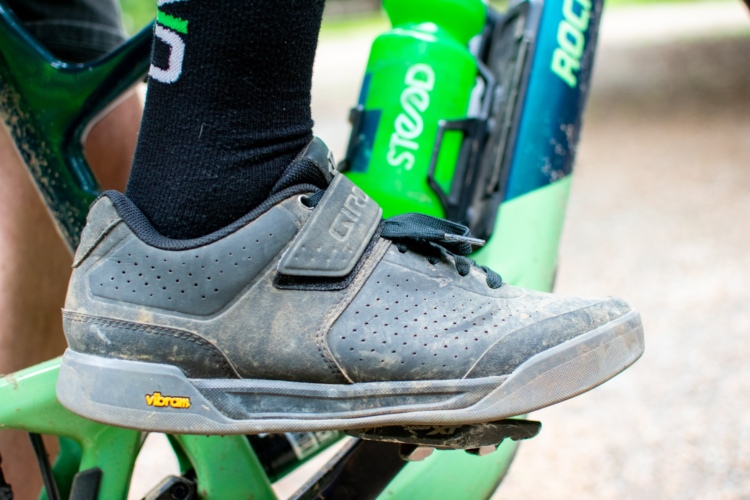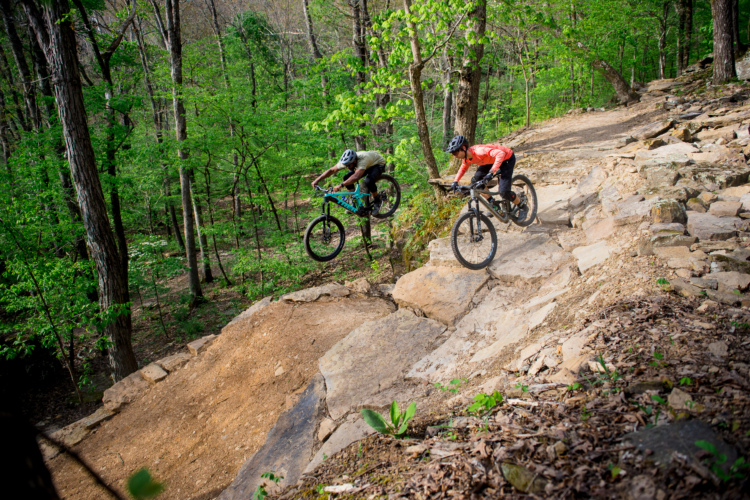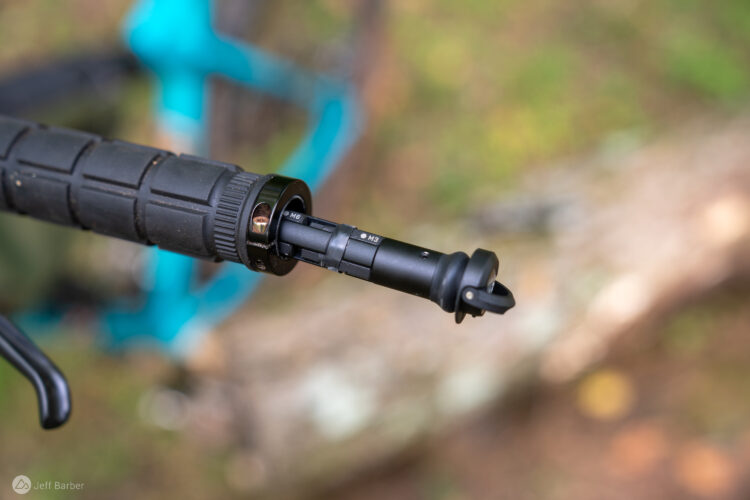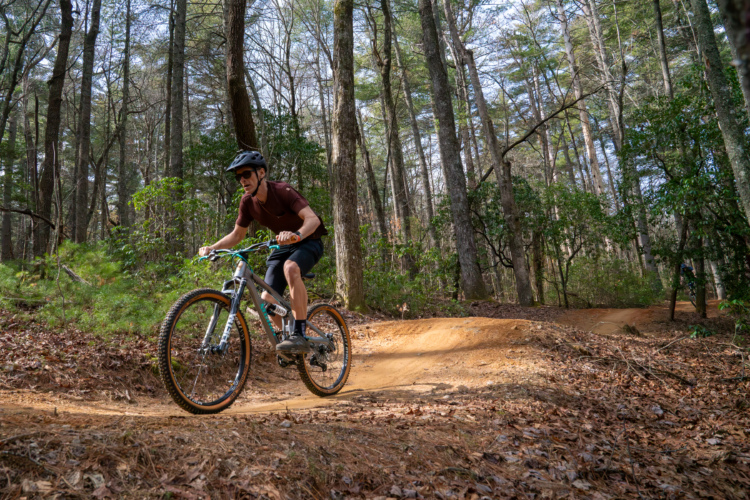
We have tested a bevy of mountain bike suspension components over the past few seasons, largely because there is so much quality squish available right now. More brands are stepping up with new and innovative products, and we want to share the meaningful differences between those components to help readers select their suspension.
Enter the SR Suntour Durolux36 Boost EQ fork. Let’s just call it the Durolux moving forward. At €630.55 (currently on sale for €504.45) its price is in line with the most affordable high-performing forks on the market, like the Marzocchi Bomber or a RockShox Yari. What makes the Durolux stand out from the others in its price range is its broad tunability, serviceability, and little touches like the full-length integrated fender and oil ports near the wiper seals.
With both high and low-speed external compression adjustments perched above a pair of high and low-speed rebound knobs, and the ability to use volume spacers to dial in the fork’s air spring, there are only a couple of forks on the market with a similar level of tunability. SR Suntour also has more affordable models that omit some of the external adjustments for riders who prefer a simpler setup.
Externally the Durolux is fairly standard, both in appearance and functionality. The fork comes in 150, 160, and 170mm travel, with 44 or 51mm offset options for the 29″ version and a 44mm on the 27.5″.

On the rigidity front, the 36mm stanchions that are pressed into a hollow aluminum crown make this fork plenty stiff. It’s currently at the front of a handful of elite EWS riders’ bikes, like Liam Moynihan’s Scott Ransom, and I would wager that it’s stiff enough for most amateur riders as well. I found that it tracked the line I wanted every bit as well as the other 36mm stanchion squishers I have tested, and I never once found myself wishing that it was stiffer.
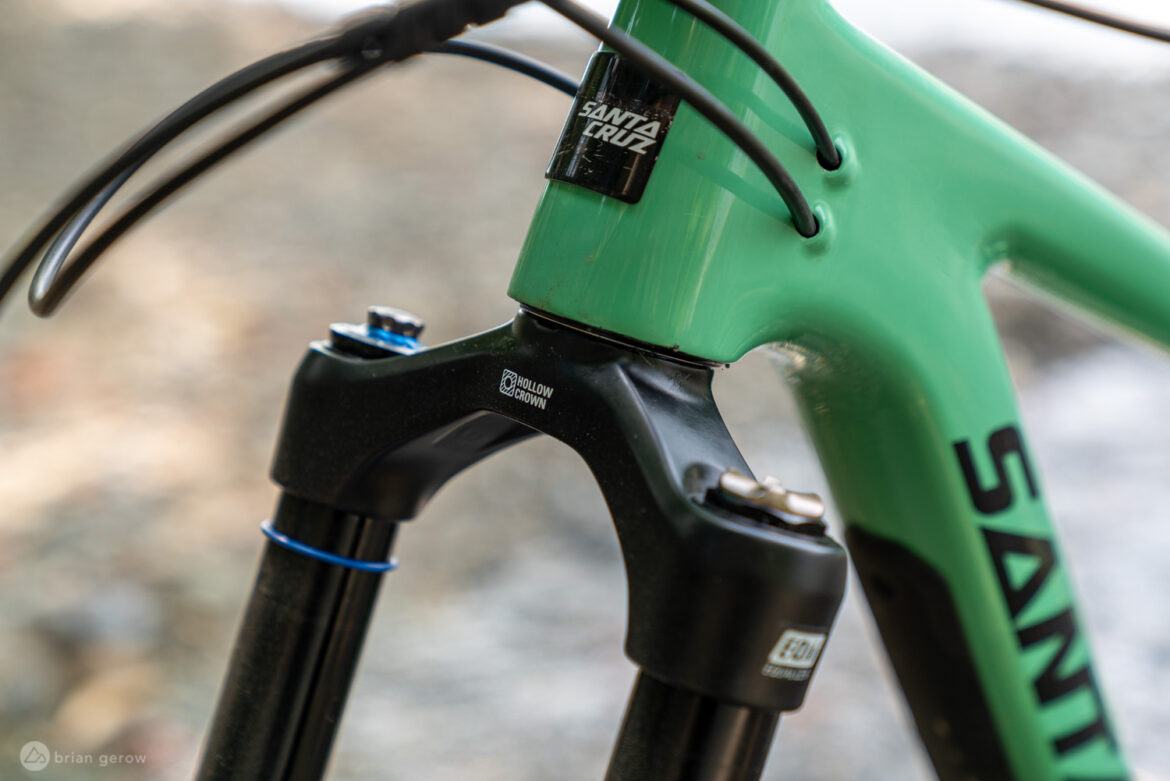
Setting up the Durolux was relatively free of fiddling. SR Suntour recommends 20-25% sag, and their PSI suggestion was nearly spot on. Compared with most factory fork recommendations I’ll even call theirs accurate. Similar to the DVO Diamond fork that’s also made in an SR Suntour factory, the Durolux Air EQ air spring has two chambers with a transfer port in the middle to equalize the pressure between them. The fork comes from the factory with three of the six possible volume spacers installed, which, like the recommended pressure, I didn’t feel the need to change much throughout the test.
| Price | €630 (about $750USD) |
| Weight | 2287g with a 190mm cut steerer, fender installed, + some dirt. |
| Travel | 150, 160, 170mm |
| Wheel size options | 27.5, 29″ |
| Offset | 27.5″ in 44mm only, 29″ in 44 or 51mm |
| Stanchion diameter | 36mm |
| Tuning adjustments | HSC 5 clicks, LSC 17 clicks, LSR 30 clicks, HSR 4, volume spacers |
| Brake mount | 180mm post mount (203mm max) |
| Service interval | 100hrs |

I clicked through multiple combinations with the rebound and compression settings on the Durolux before landing in a spot that is quite close to where I began, again not far off of the recommended settings. Of note, with around 20% sag to keep the bottom-outs away, I found that the fork felt better with added compression to increase support, rather than pumping up the air pressure. While I typically prefer fork performance with the compression circuits as wide open as possible, allowing the air spring to do most of the work, this fork clearly has different setup and functionality characteristics. The rebound and compression ranges are reasonable and wide, and there is plenty of room for heavier riders to add support and lighter folks to fine tune the fork’s traction characteristics.
The low-speed rebound knob moves along with the high-speed knob, so you’ll want to set the high-speed first. Also, high-speed rebound “clicks” on the fork I tested are extremely hard to feel, and inaudible. You have to sort of feel for where you want it to go, and trust that it will stay there. While this isn’t a huge issue, I would prefer to have clear clicks in the rotation so I know exactly where the dial is.
Trail time

I mounted the Durolux on the front of a Santa Cruz Megatower, and tested the two in tandem. The Megatower came with a Fox 36 Performance fork and GRIP damper, and I rode the bike a few times with that very familiar stock setup before swapping in the Durolux. I made plans to travel with the bike and had a hunch that the more tunable fork would better suit the changes in terrain.
My local trails are good for pushing test bikes and components to a point, but the real laboratory for this fork was on the long and rough descents at La Thuile Bike Park. With some of the trails coasting along the rocks and roots for 20-30 fast minutes, a proper suspension setup is the difference between enjoying the second half of the descent or sitting alongside the trail massaging your hands two or three times per lap. While powerful brakes and robust tires also play a crucial role in the gravity endurance equation, there is no question that those long alpine slopes are the right place to test a fork marketed for “enduro/freeride” use. I had a full week of all-day-long vacation laps, skipping lunch whenever possible, followed by a regular workweek with lunch laps to see how the Durolux does on the former EWS stages.
I spent the testing portion of each park day mostly riding two trails, each with notably different build characteristics. Vertical is a black-rated trail that descends the lower half of the mountain, continuously pitching steeper as it leans toward the Aosta valley below. It’s riddled with little root doubles and a series of kneehigh drops that require a fairly precise amount of speed to ride in control. The track finishes with a handful of fast and dusty steep turns that are of far less consequence compared to the lines above.
This trail was where I pushed on the Durolux to get a sense of its composure and support, as well as the loft it provides with rider input. I was stoked to feel a similar level of compression and quick recovery to what I have experienced from forks twice its price. In fact, when things are a little more technical, and less full throttle, it would be tricky to distinguish the Durolux from most other 36mm forks with a similar tune. The fork catches my weight and recovers well without having the rebound wound all the way open, which would mess with traction. I only managed to bottom it out twice, and both times were emergency landings where any fork would have clanged to a halt. Given how hard I was able to push the Durolux into the rooty turns and compressions while feeling supported on successive square edge impacts, I’d say SR Suntour has nailed their suggested setting range.
To test the Durolux at something more like race pace, I hopped the second lift to the iconic Cambogia trail each afternoon. At roughly twice the length, a fair bit rougher, and far steeper toward the end, any gravity component worth its carbon or alloy can be properly tested on Cambogia. The singletrack starts from a rocky knoll, ripping quickly through some technical rock faces into an exposed no-brakes bench cut segment. Then it points down. I managed to get the bike up to the maximum level of speed that I’m comfortable with before dipping into the maximum level of steep that I’m comfortable with. Maybe I wasn’t only testing components…
With a coil on the tail end of this fairly long Santa Cruz frame, high speed riding feels about as smooth as it can. That pillowy rear end also made it easy to pay close attention to the fork, which was slightly less buttery at my max velocity. While the fork did maintain grip about as well as it should for the given terrain, tires, and rebound settings, it had some vibrational harshness that was eating away at my hand-strength endurance. I realized that I had clicked the knobs a long way from their original position since the first ride, and decided to rotate them a little closer to where the engineers suggested they should go. That reset helped matters considerably. I had added air and removed compression, and the fork was packing (remaining low in the travel, unable to recover prior to the next impact). I find this surprising because I have yet to mesh well with factory fork settings from other brands. I then remembered that the fork has a pair of screws in the lowers, just behind the wiper seals. They are there so that you can add a touch of oil between service intervals, and to relieve air pressure in the lowers when you change altitude, similar to the buttons on the trailing edge of the new Fox 36 and 38 forks. I was riding about 1500 meters above where I live, and when I removed the screws they gave an audible sigh. So did I.
In conclusion
With the settings reset, I rode another few days with notably less hand pain and wider smiles. In almost every enduro-esque riding situation the Durolux performed admirably, and if it were my personal fork I would undoubtedly be happy with the purchase. I would be stoked that it saved me some cash while functioning at a level that didn’t slow me down or hinder my trail time. With all of the settings as dialed as can be, it does lack a sliver of the true butter-supple feel that some forks have, but I would argue it makes up for that difference in the price department. SR Suntour has done a solid job with this fork and I look forward to seeing what other gravity goods they come up with.

We would like to thank SR Suntour for sending the Durolux36 Boost EQ over for testing and review.








